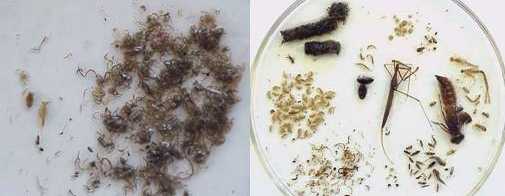Home → Land Resources → Monitoring & Assessment > Biomonitoring > Why
 Why Biological Monitoring?
Why Biological Monitoring?
Protection of Maine's freshwaters
Maine is well known for its plentiful wilderness areas. Rivers, streams, and wetlands located in these areas contain a rich diversity of aquatic life, including algae, macroinvertebrates, fish, amphibians, and mammals.
Increasing development in Maine as our population grows puts greater pressure on Maine 's freshwater ecosystems. Pesticides, fertilizers, soil erosion, road salt, and other pollutants run downhill during rainfall and find their way into our freshwater streams, rivers, wetlands, and eventually into the Gulf of Maine. Elevated levels of these contaminants can cause unsightly algae blooms that consume the oxygen found in the water body, making it uninhabitable for certain kinds of organisms. Toxic substances found in runoff are harmful for the animals that live in our freshwaters, and can potentially be harmful to us.
Development can also cause changes in stream shape and flow levels, causing some types of habitat (such as loose cobble and riffles) to disappear. Wetland habitat is often lost entirely when areas are heavily developed. Since colonial times, about 20% of Maine 's wetlands have been lost due to development.
To make sound decisions in management, planning, and regulation of our freshwaters, it is essential to gain a better understanding of the relative risks our human activities pose to rivers, streams, and wetlands. Sources and causes of the degradation of these habitats and long-term trends in ecosystem health need to be identified so that our water bodies can be protected.
The Federal Clean Water Act
Under the Federal Clean Water Act (section 101), states are required to develop programs that evaluate the physical, chemical, and biological integrity of the Nation's waters, and to adopt water quality standards to restore and maintain that integrity. States must report to Congress on the condition of all waters within their boundaries every two years.
Physical and chemical data are traditional measures of ecosystem health. These data include measurements of dissolved oxygen, dissolved organic carbon, and the concentration of various toxins, amongst other things. Biological integrity, widely defined as The ability of an aquatic ecosystem to support and maintain a balanced, adaptive community of organisms having a species composition, diversity, and functional organization comparable to that of natural habitats within a region, was a newer addition to the set of tools used for monitoring aquatic ecosystems. To develop specific criteria within the State's Water Quality Classification Law that supported the standards of physical, chemical, and biological health set forth in the Federal Clean Water Act, the DEP initiated a statewide biological monitoring program in 1983.
The following pages discuss water quality classification in more detail:
Classification of Maine Waters (Maine DEP)
What Are Water Quality Standards? (EPA)
The advantages of biological monitoring
Traditional physical and chemical measures of water quality (called performance based standards) are useful to help determine sources of water contamination, but they only indirectly measure the health of the aquatic ecosystem because they don't look directly at biological responses to pollution. Ecosystems are composed of both physical and biological components. The most direct way to understand the health of the organisms in an ecosystem is to monitor them directly.
Aquatic organisms are also useful as indicators because they cope with chemical, physical, and biological influences in their habitat over the course of their entire aquatic lifecycle, which in some cases can be multiple years. Chemical water samples serve only as a snapshot of ecosystem health, since chemical concentrations may be highly variable from day to day depending on the timing of discharges, precipitation events (e.g. rain) and water flow patterns. Chemical sampling also does not evaluate biological threats to ecosystem health, such as the presence of invasive species. Biological communities integrate all of the environmental stresses caused by human and natural activities over a longer period of time. As a result, the numbers and types of organisms present in a water body reflect the quality of their surroundings. Inventorying the makeup of aquatic communities and comparing these results to pollutant-free areas makes it possible to determine whether pollution is causing effects such as the loss of sensitive groups of organisms.
An example of how aquatic macroinvertebrate communities are affected by pollution is given below. In the invertebrate sample from an undisturbed wetland (right) many groups of sensitive organisms are present, and organisms tolerant to pollution are present only in low numbers. In the invertebrate sample taken from a polluted wetland (left), sensitive organisms have been eliminated from the ecosystem and tolerant organisms have proliferated.

Why monitor invertebrates and algae?
Macroinvertebrates and algae make good biological indicators for a variety of reasons. Macroinvertebrates live on the bottom of rivers, streams, and wetlands. During their aquatic life cycle they have a much more limited mobility than fish, making them less able to avoid the effects of pollutants. However, because many macroinvertebrates grow up to be terrestrial adults, they are able to colonize habitats where natural obstructions may exclude fish. Macroinvertebrates also have a wide range of pollutant tolerances amongst the various species. They can be found in all but the most severely polluted or disturbed habitats. They are also practical and easy to sample using accepted and well-established sampling and analysis procedures.
Algae have shorter lifecycles than macroinvertebrates. As a result, algal communities react more quickly to environmental stressors. Changes in the algal community of a water body can often be a preliminary warning sign that pollutants or other environmental stressors are being introduced. This is particularly true of nutrient pollution, which causes dramatic shifts in algal form that are the precursor for low oxygen conditions that can affect macroinvertebrates and other organisms higher up the food chain.